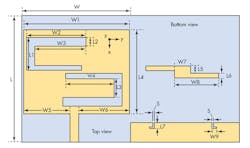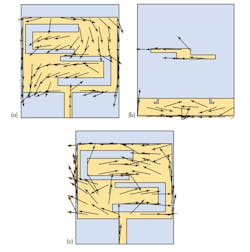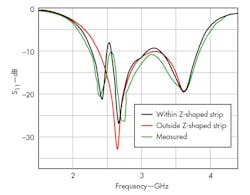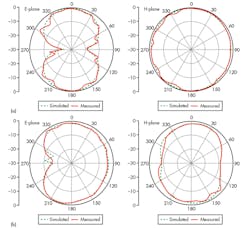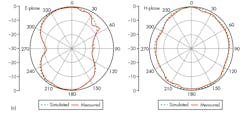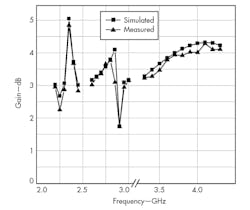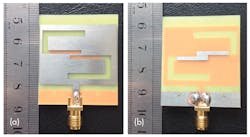This file type includes high resolution graphics and schematics when applicable.
Expanding wireless applications are creating unprecedented needs for equipment (such as antennas) at different frequency bands, as well as for different applications. Fortunately, a novel antenna was developed capable of handling three separate wireless bands within the same compact structure.
The antenna structure in question consists of two U-shaped slots in a rectangular patch and a Z-shaped strip at the ground plane. It can handle three distinct frequency bands centered at 2.45, 2.64, and 3.44 GHz for wireless communications applications. The two U-shaped slots support two of the frequency bands, while the Z-shaped strip is used for the other resonant frequency.
The antenna, which is printed on low-cost FR-4 substrate material with thickness of 0.8 mm and relative dielectric constant of 2.95, has overall dimensions of 34.5 × 40.0 mm. Simulation and measurement results show that the proposed antenna configuration can be applied to applications in wireless local area networks (WLANs), Fourth-Generation (4G) cellular equipment, and WiMAX devices with almost omnidirectional radiation patterns.
As wireless applications have spread, requirements have increased for sufficiently small printed antennas that can be produced at low cost. Increasing attention has been paid to antenna designs capable of handling two or more wireless frequency bands within one compact structure, although the frequencies of interest may vary depending on the geographic area and/or country.1 For example, within the wireless communications bands, the 2.45-GHz frequency band is used by WLAN services and equipment, the 2.60-GHz frequency band is used by 4G cellular communications systems, and frequencies from 3.3 to 3.6 GHz are used by IEEE WiMAX systems.
Various types of traditional multiband antennas have been proposed and published for multiband wireless communication applications.2,3 Many can be categorized as the elliptical slot antennas, compact slot antennas, and antennas with dual-band-notched characteristics.4-6 To enhance or notch the impedance bandwidth of these multiple-frequency-band antennas, slots with different shapes are used.7,8
In the current article, a novel tri-band slot antenna is proposed, featuring a simple architecture and performance that is well suited for wireless applications. Two U-shaped slots are used to produce dual-band resonant modes. The proposed antenna employs two L-shaped slots in the ground plane to broaden the impedance bandwidth, which can easily cover the WLAN, 4G cellular, and WiMAX bands.9,10
This antenna offers promising features, including good impedance matching over the full operating frequency range and stable radiation patterns. In the analysis of the design, good agreement has been achieved between computer simulations and measurements of fabricated antennas.
Figure 1 shows the configuration of a triband slot antenna as well as the coordinate axis. The antenna is printed on FR-4 substrate with thickness of 0.8 mm, relative permittivity of 4.3, and loss tangent of 0.02. The antenna is fed by means of a 50-Ω signal strip transmission line. Two U-shaped slots in the rectangular radiating patch generate two resonant modes, while the other resonant frequency is produced by the Z-shaped strip. The L-shape slots help enhance the impedance bandwidth.
The antenna was simulated and optimized with the help of the High-Frequency Structure Simulator (HFSS) electromagnetic (EM) simulation software from Ansoft using the finite-element method (FEM). The table shows the antenna parameters and their optimized values (in mm).
This file type includes high resolution graphics and schematics when applicable.
A Closer Look
This file type includes high resolution graphics and schematics when applicable.
Figures 2(a) and (b) illustrate the current distributions of the proposed triband slot antenna at different frequencies. As shown in Fig. 2, the U-shaped slots increase the current routes to achieve two resonant bands while the third band is achieved by the Z-shaped strip at the back of the substrate. Figure 3 plots the antenna’s measured and simulated S11 responses as functions of frequency. As these responses show, the simulations agree closely with the measured results at the three frequencies of interest: 2.45, 2.64, and 3.44 GHz.
Figure 4 shows radiation patterns for the prototype antenna measured at 2.45, 2.64, and 3.44 GHz. The radiation patterns in the xz-plane and yz-plane correspond to the antenna’s E-planes, while the radiation patterns in the xy-plane correspond to the antenna’s H-plane.
At low-band frequencies, a figure-eight radiation pattern is obtained in the E-plane, while a nearly omnidirectional radiation pattern is associated with the H-plane. Although the patterns obtained for this antenna are not as good as those for a simple conventional monopole antenna, they are close to monopole-like patterns for a multiband configuration.
In Figure 5, the measured gain varies across a range of about 2.24 to 4.89 dBi in the first frequency band, about 1.71 to 4.70 dBi in the second frequency band, and about 3.12 to 4.19 dBi in the third frequency band. However, the gain variations extend more than 1.0 dB across the operating bandwidths in the first and second frequency bands.
Because antenna gain is a function of its electrical dimensions relative to the wavelength of interest, current distribution, and radiation pattern, the proposed antenna has higher gain in the lowest-frequency band. Figure 6 presents a photograph of the prototype fabricated triband antenna.
In short, the antenna is a compact design that shows great promise for handling multiple frequency bands in wireless applications. By using two U-shaped slots and a Z-shaped slot, it achieves three resonant operating bands on low-cost circuit-board material.
Owing to the L-shaped slot in the ground plane, the bandwidths are enhanced further. Simulations and measurements have indicated that the proposed antenna can be effectively used for WLAN, 4G cellular communications, and WiMAX applications.
This file type includes high resolution graphics and schematics when applicable.
Acknowledgment
This file type includes high resolution graphics and schematics when applicable.
This research was supported financially by a grant from the National Science and Technology Major Project (No. 2012ZX03006003).
Wang Maowen, Professor
Cao Jianzhong, Professor
Peng Wenjuan, Professor
Huizhou University, Department of Electronic Science, Huizhou City, Guangdong Province, People’s Republic of China
References
1. A. Kerkhoff and H. Ling, “Design of a planar monopole antenna for use with ultra-wideband (UWB) having a band-notched characteristic,” in IEEE AP/S International Symposium Digest, Columbus, OH, June 2003, Vol. 1, pp. 830-833.
2. Z.N. Chen, D.X. Liu, and B. Gaucher, “A planar dual band antenna for 2.4 GHz and UWB laptop applications,” in Proceedings of the IEEE Vehicular Technology Conference, Melbourne, Australia, May 2006, Vol. 6, pp. 2652-2655.
3. S.K. Mishra, R.K. Gupta, A. Vaidya, and J. Mukherjee, “A compact dual-band fork-shaped monopole antenna for Bluetooth and UWB applications,” IEEE Antennas & Wireless Propagation Letters, Vol. 10, 2011, pp. 627-630.
4. R. Fallahi, A.A. Kalteh, and M.G. Roozbahani, “A novel UWB elliptical slot antenna with band-notched characteristics,” Progation of Electromagnetic Resonances, Vol. 82, 2008, pp. 127-136.
5. L. Dang, Z.-Y. Lei, G. L. Ning, and J. Fan, “A Compact Microstrip Slot Triple-Band Antenna for WLAN/WiMAX Applications,” IEEE Antennas & Wireless Propagation Letters, Vol. 9, 2010, pp. 1178-1181.
6. Wen Tao Li, Yong Qiang Hei, Wei Feng, and Xiao Wei Shi, “Planar antenna for 3G/Bluetooth/WiMAX and UWB applications with dual band-notched characteristics,” IEEE Antennas & Wireless Propagation Letters, Vol. 11, 2012, pp. 61-64.
7. R. Caso, A. Serra, A. Buffi, M. Rodriguez-Pino, P. Nepa, and G. Manara, “Dual-polarized slot-coupled patch antenna excited by a square ring slot,” Microwave Antennas & Propagation, Vol. 5, 2011, pp. 605-610.
8. L.H. Ye and Q.X. Chu, “Improved band-notched UWB antenna,” Electronic Letters, Vol. 45, No. 25, December 2009, pp. 1283-1285.
This file type includes high resolution graphics and schematics when applicable.


